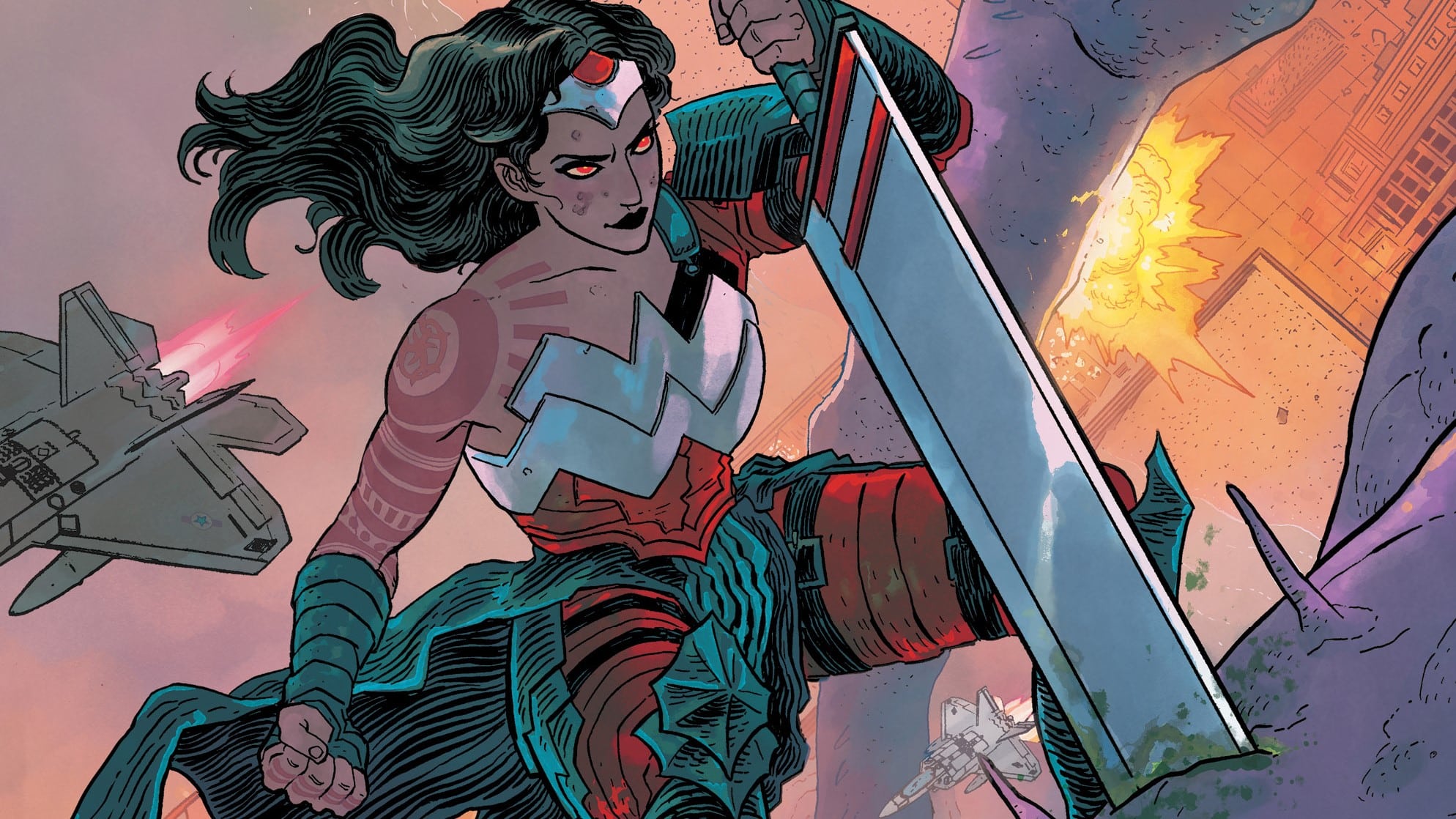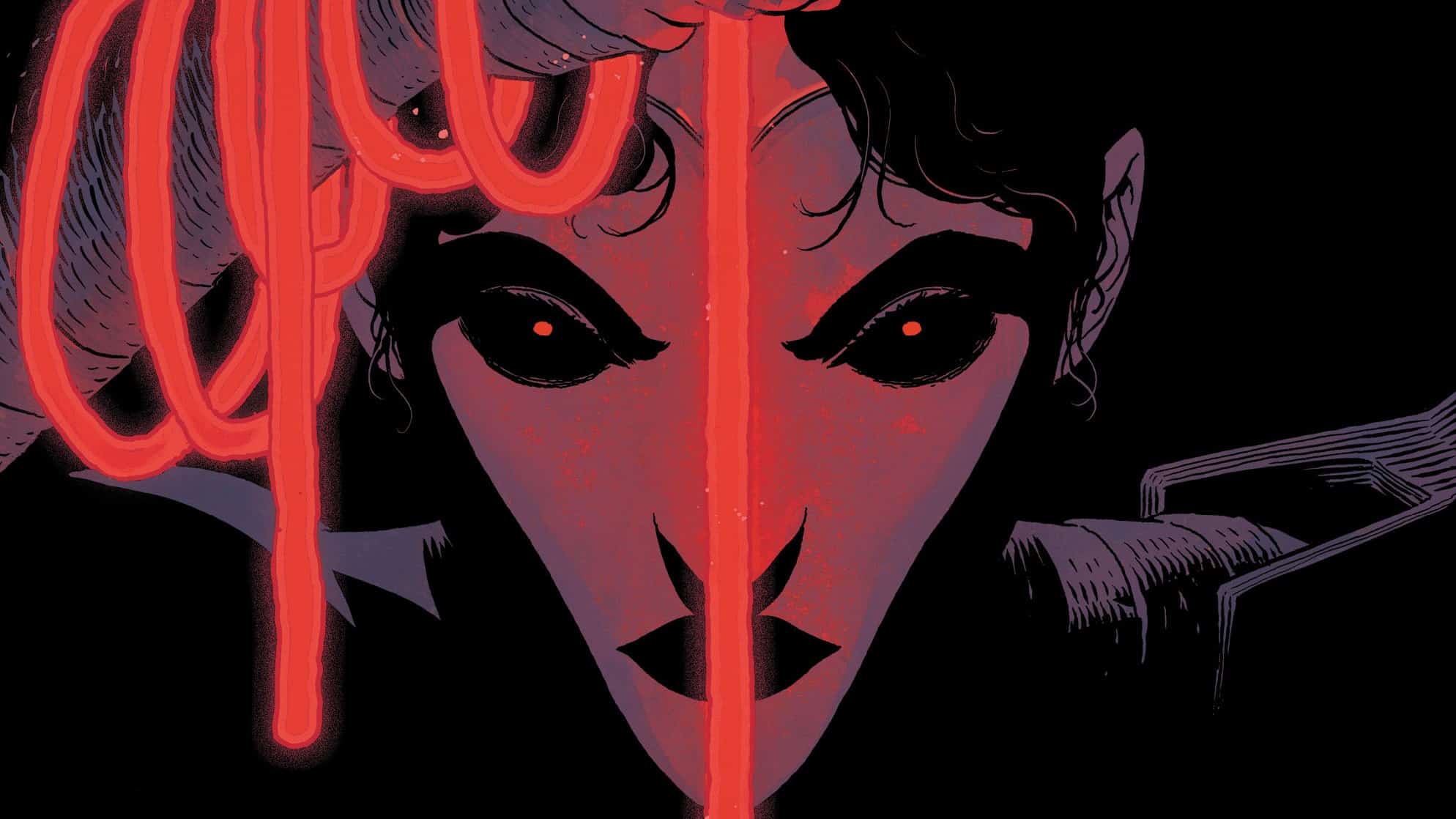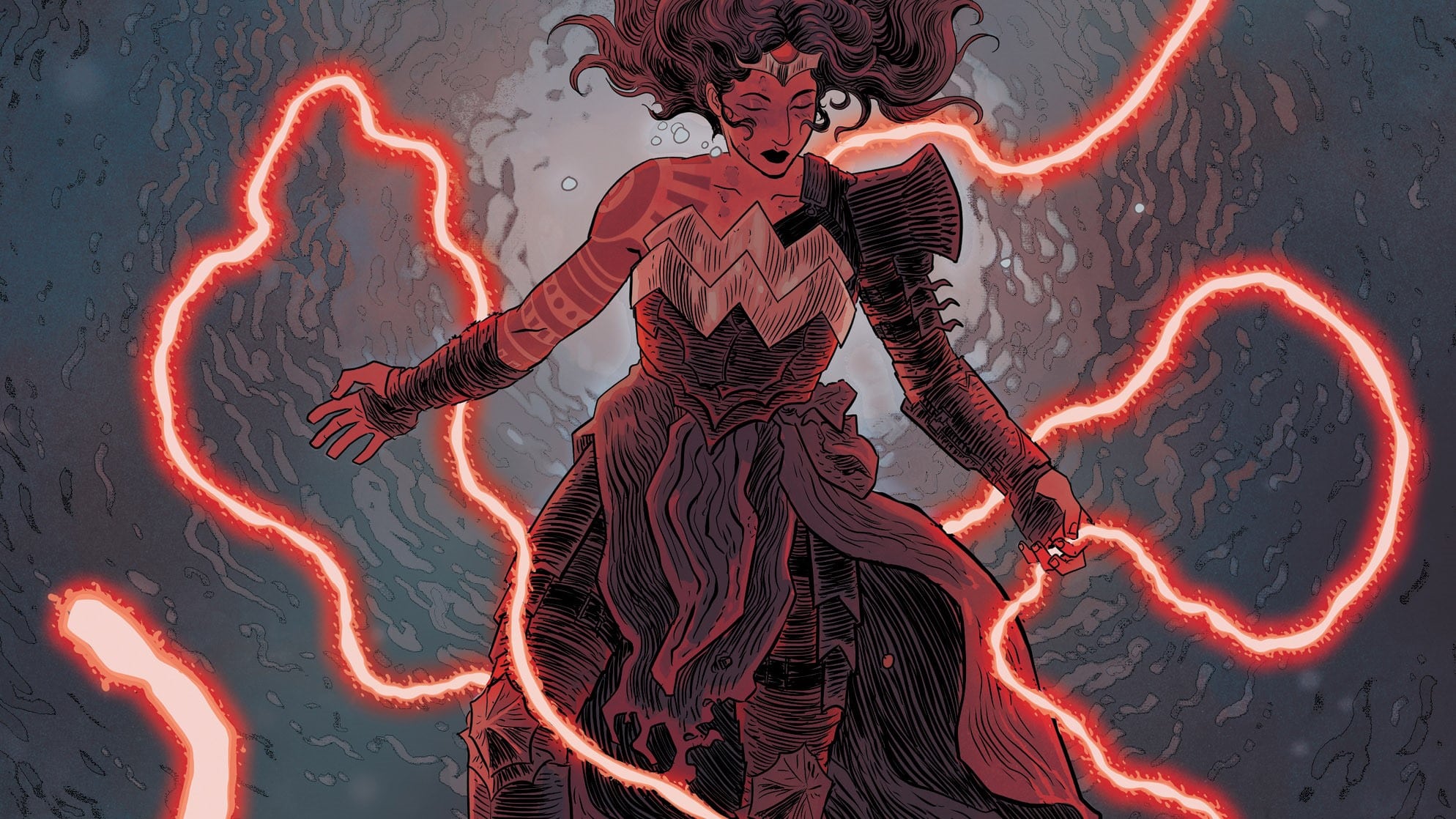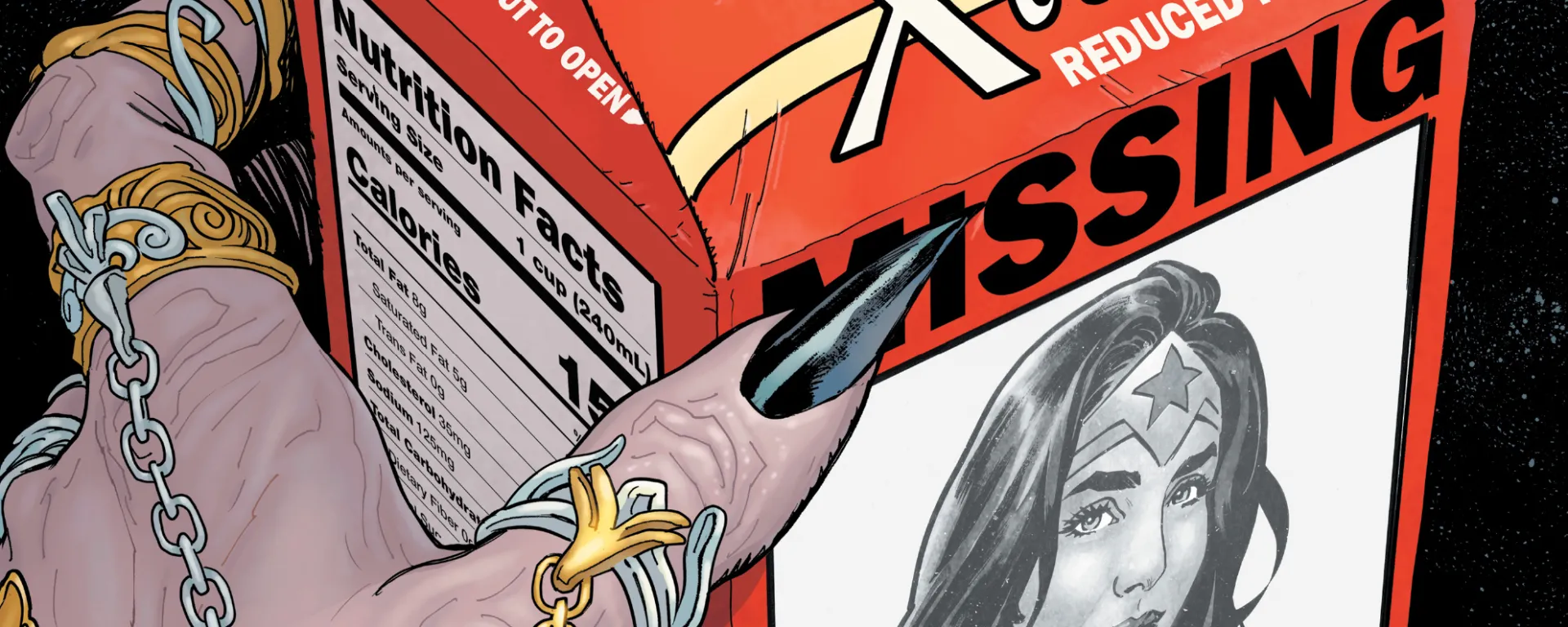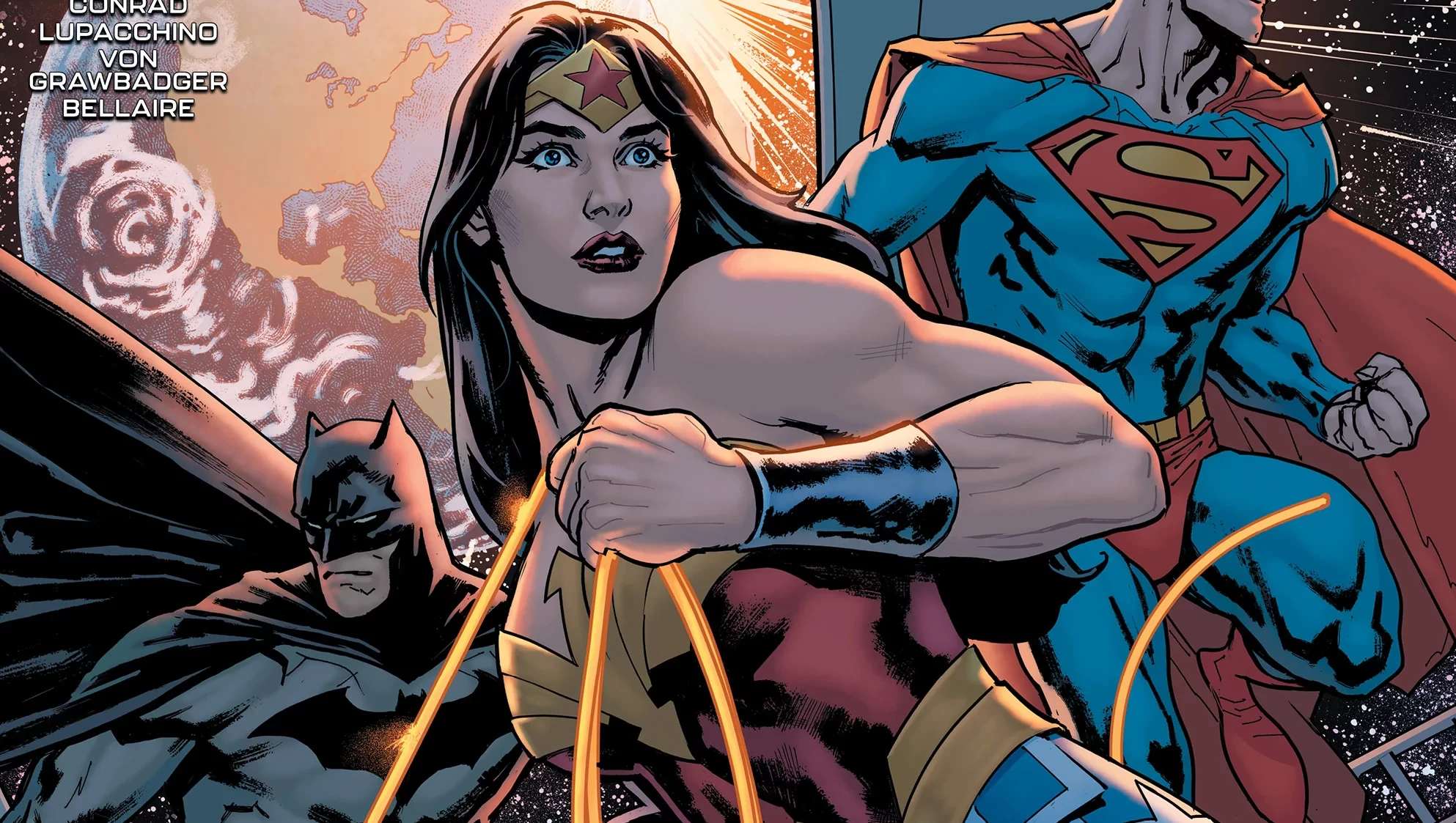The Tetracide is “The Four Killer,” and Diana has done the unthinkable to escape its fatal grasp. The move may have saved her to fight another day, but the price Diana paid is more than she can stand to lose for the fight that’s coming. She will need the help of her allies both old and new to recover what she has lost — and save Gateway City! Absolute Wonder Woman #4 is written by Kelly Thompson, drawn by Hayden Sherman, colored by Jordie Bellaire and lettered by Becca Carey.
Jake Murray: Hey everyone, and welcome to ComicsXF’s coverage of Absolute Wonder Woman. It’s fair to say that Kelly Thompson and Hayden Sherman’s reimagination of Diana’s origin as an Amazon cast out from paradise and into literal hell has been a success so far, garnering praise from fans and critics alike. It’s only appropriate, then, that we give it the CXF treatment, and dig seven circles deep into this series, issue by issue, blow by giant sword blow. To lend me her strength, her conviction, her indomitable will, I’m delighted to introduce, or should I say reintroduce, my partner on this expedition, Cat Purcell!
Hey, Cat. Welcome back. Before we get into it, how have you been enjoying Absolute Wonder Woman so far, and what have you made of DC’s Absolute initiative generally?
Cat Purcell: Hi, Jake, thank you for such a warm welcome! I’m so pleased to get to return to writing for ComicsXF, especially on one of my favorite superheroes. When Becky Cloonan and Michael Conrad handed the reins of my gal over to Tom King, well, to say I was disillusioned was an understatement. I’d also become a little disillusioned of Kelly Thompson’s work on Captain Marvel at the end. However, once DC announced Thompson was writing Absolute Wonder Woman, putting her in Hell and having her be raised by Circe, I was excited again. Sherman draws her massively and with compassion at her core, which I can’t help but enjoy.
I haven’t fully read Absolute Superman and barely dipped into Absolute Batman, but stripping these characters down to their core values and spinning their origins upside down has been fun. Playing in the sandbox and giving a creative team freedom to reinvent the wheel is always a good choice.
A Fillet of Tetracide

Jake: Let’s begin with the Diana-centric plot summary. Having just kept the Tetracide at bay by placing the population of Gateway City under a spell to make them temporarily deaf, she has protected them from the beast’s seductive death sound. In need of a magical level up, and the return of her magical arm, Diana visits Etta and Gia Candy along with Steve Trevor. She gains the tools she needs to go out and take down the kaiju once and for all, luring it away from the city by conjuring the death cries of its entire population before increasing the size of her magical sword to that of a skyscraper. Having achieved suitably absurd scale, she flies up above the Tetracide and drops her Damoclean sword, chopping the beast in half with satisfying precision. Meanwhile, National Security Adviser Veronica Cale watches on from the Oval Office and begins to hatch her plans to contain America’s newest hero.
I honestly don’t know how you don’t start with the massive sword. Cat, what did you make of the action in this issue?
Cat: Ha! Back in issue #3, she had some trouble with it sticking, and I wonder if that had something to do with the Tetracide not being wound down enough yet or perhaps Diana had to make that sacrifice to really make her sword make a difference. Either way, I’m not one to complain about more women wielding giant swords. Much like the deus ex machina of Etta’s magically inclined secret sister, the sword did seem a bit of a perfect fix all at once, huh, Jake?
Jake: It did, and this is always the risk with designing plots centered on threats who “can’t be beaten”: You’ve got to be very clever in designing yourself out of it. The fact Diana managed to save the city with almost zero casualties when Thompson had presented death as somewhat of an inevitability makes it fall a bit flat, although there’s something about “obscenely giant sword conquers humanity’s existential dread over the inevitability of death” that’s so on the nose for superhero comics that I almost have to respect it. This whole setup was primarily an opportunity for Diana to show off her battle skills, which was great.
I also think the issue did a great job of accentuating the duality of the character. Throughout each issue so far, Thompson has divided Diana’s scenes between interactions with the citizens of Gateway City and insight into the Hell-raised goddess hero. The scenes with Etta and Gia demonstrate Diana’s universal respect and admiration for the human spirit, and those who best embody it. The fact that she found Gia’s willingness to help as inspirational as Gia found her heroism is a great example of this. This helps bring out both sides of Diana.
Firstly, the mythic: Diana’s prodigious might, imbued with the physical strength of gods but also the strength of character developed through years of being raised in a warrior culture, or in Hell as the case may be. Secondly, the human: Diana’s resoluteness, her compassion, her ability to inspire strength in others. These are all deeply human ideals and traits.
Cat: I like what you said about the duality of her character! I noticed this too, but it’s subtle enough in the construction and framing of the scene between Gateway City and Hell that it kind of bubbles below the surface. Her time in Hell contrasts and complements the personality traits of Diana. She is a person whose very nature draws respect and collaboration from others, as seen in her ability to tame monsters and attract the U.S. military’s rapt attention before heading to battle with a ginormous beast. At the same time, she’s a ruthless warrior, not afraid of losing an arm or going out of her comfort zone to spare lives (even if the number of lives saved is too good to be true 😉). In a strange way, the flashbacks of Diana’s time in Hell are peaceful and calm compared to the chaos and urgency of Man’s world.
I am excited about the introduction of Cale, though. Much like the teaser introduction of Dr. Barbara Minerva, I’m curious to see how these two anti-heroes are going to differ from their counterparts in the original ethos. I think Veronica Cale usually serves as a good foil to hone whatever values Wonder Woman is most used to represent in a writer’s run. I definitely think she’ll do a good job of showing how dangerous Diana can be, and I hope her addition is worth it. And I think that, as you noted, Wonder Woman’s knack for drawing people’s support to her and her ridiculous might are exactly what Veronica and many in the U.S. government would consider a bigger threat than a giant tentacled Tetracide.
Hecate, hear me

Cat: I truly love the throughline set up of Hecate as a mother figure to Circe and Circe as Diana’s here. The contrast of both Circe rejecting what Hecate has given her along with Diana having recently rejected what Circe provided her was a great way to show their relationships. We can’t always give the ones we love what they want, just as we can’t always protect our loved ones from harm. The black and red tendrils of these pages also echo the way Diana’s eyes flash and change. This is a series I have paid twice to own both digitally and physically, and these creative panels and rippling details are exactly why. Some of these spreads have to be seen on the page.
Other details, like the mass of monsters that sleep at young Diana’s head like plushies and differences in Greek and English “spell” language, in concert with the clever panel spacing, really pull me in. What did you take away from the art in this issue?
Jake: I have to call out Hayden Sherman’s art, including their phenomenal layouts. The action on the page is overlaid with some kind of godhead figure, which dictates how the panels are organized. The implication here, which we begin to surmise through the narrative, is that there’s a divine hand guiding events. This is most prominent initially in the Circe scenes but is transferred to the scenes with Diana, which introduces a narrative layer above and an element of mystery to what we’re seeing on page.
I also love the way they represent magic as a transformative force on reality rather than a nebulous energy force. The colors and letters elevate each of the two elements of magic (language, energy) brilliantly in turn. Jordie Bellaire’s colors establish a visual language to the magic, with different spells carrying different color signatures, while Becca Carey’s letters give the words form and movement. The whole creative team are working in perfect harmony here, and are finding new and exciting creative solutions to make each and every page sing.
The essence axis

Jake: While I’ve been very much enjoying Thompson’s Diana and this series generally, one question that’s been playing on my mind is: “Is this just a great Wonder Woman comic?” I say just because this needles at the heart of alternate universe stories generally. Something I’ve found very striking with Absolute Wonder Woman (and its Batman and Superman contemporaries) is that while the origins may be different, the lead characters feel very similar to their mainline-universe counterparts. Diana, for example, is still extremely bold and brave, a dynamic and creative problem solver and extremely virtuous (more importantly, though, her virtue is remarked upon regularly by other characters).
Story variance in superhero alternate universe stories generally works on an axis. On one you have context — the fictional world and its social and cultural norms and practices. On the other is “character essence,” the set of values and beliefs that make a character them. In some stories, the correlation between these two variables is strong. In other words, a character’s central belief system and therefore values and behaviors are shaped by the world around them. It’s the classic nature vs. nurture argument. Take Deniz Camp’s The Ultimates, for example. Characters like Reed Richards and Janet Van Dyne are shaped by the grief and merciless legacy of The Maker’s pre-emptive strike on the heroes of that world.
The characterization of Diana works because the values instilled in her by Circe are complemented by the sense of prophetic purpose granted to her by the gods, but it feels as though that set of circumstances has led her back to being a very similar version of the character. She is defined by a fixed sense of self, her essence rather than the world around her. I have found this generally with the Absolute line. Perhaps it comes back to the “pantheon of the gods” approach they took right back at their inception, or perhaps there’s a more 21st century preservation of IP reason. Either way, it’s not an inherently bad thing, and there’s no right or wrong way of doing AU characterization. It all comes down to preference, and mine would be for the world to more fundamentally influence the character. Yes, Diana has learned magic from being raised in Hell, but I’d be curious to see how else this has shaped her. This isn’t a big complaint, I would have just welcomed a more radical variation on the character. Again though, I’d happily take just another great Wonder Woman story, and I’ve really enjoyed this one so far.
Cat: I agree, this does seem like just another great Wonder Woman story. The worldbuilding and character shaping are deep and evident without lengthy dialogue and backstory. I think you hit a good point there, Jake, in that this version of the trinity in the Absolute line seems to strip these three supers down to their core. It also reminds me of what Will Nevin and Matt Lazorwitz touched on in their initial coverage over in BatChat: Hope, justice and compassion in the purest forms of Superman, Batman and Wonder Woman. I agree that circumstances make a person just as much as nature does, and these three iterations indicate that nurture hasn’t been too important to these characters.
However, I do think there are some core elements to people, things about them that will always be a part of who they are. Like my 3-year-old who wakes up like clockwork at exactly 5:18 a.m. like he has since he lived inside my body. Or like my 6-year-old who arrived two weeks early and continues to dive head first into everything she does without thinking. Although nurture and experience definitely shape a person, their choices and their values, I have seen my own children be driven by qualities innate in them from the get-go.
I really enjoy this exercise DC is taking in the form of the Absolute line. It’s by no means perfect, and I don’t think it’s groundbreaking, but I really leave each issue excited to see what the next one brings for the characters.
Buy Absolute Wonder Woman #4 here. (Disclaimer: As an Amazon Associate, ComicsXF may earn from qualifying purchases.)

